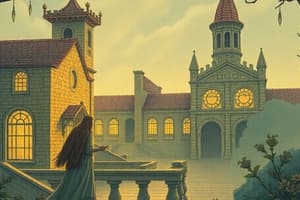Podcast
Questions and Answers
What was the primary religion practiced by the Celts?
What was the primary religion practiced by the Celts?
- Polytheism
- Paganism
- Christianity
- Druidism (correct)
Who was responsible for building Hadrian's Wall?
Who was responsible for building Hadrian's Wall?
- Emperor Claudius (correct)
- The Picts
- The Angles
- Julius Caesar
What was significant about the Anglo-Saxon Heptarchy?
What was significant about the Anglo-Saxon Heptarchy?
- It marked the end of Roman influence.
- It divided England into seven kingdoms. (correct)
- It was a period of Viking rule.
- It lasted from 410 CE to 660 CE.
Which event marked the beginning of Viking raids in Britain?
Which event marked the beginning of Viking raids in Britain?
Who unified the Anglo-Saxons against the Danes?
Who unified the Anglo-Saxons against the Danes?
What significant event marked the end of the Anglo-Saxon reign in England?
What significant event marked the end of the Anglo-Saxon reign in England?
Which document did William I commission to survey the land and wealth in England?
Which document did William I commission to survey the land and wealth in England?
Which event did NOT occur during the reign of Henry II?
Which event did NOT occur during the reign of Henry II?
What was one of the primary consequences of King John I's signing of the Magna Carta in 1215?
What was one of the primary consequences of King John I's signing of the Magna Carta in 1215?
Which statement is true regarding Henry I's succession crisis?
Which statement is true regarding Henry I's succession crisis?
Study Notes
Celtic Britain
- The island of Britain experienced a succession of invasions that brought about different languages and beliefs.
- The Celts, divided into three main groups: Gauls, Britons, and Gaels, spread across Europe.
- The Celts spoke similar languages and practiced Druidism, a religion centered on the worship of the sun god.
Roman Britain
- The Romans began raiding Britain in 55 BCE with Julius Caesar.
- Under Emperor Claudius, England and Wales were conquered in 43-54 CE.
- The Picts of Caledonia (Scotland) resisted Roman rule.
- To protect ‘Britannia’, the Romans constructed Hadrian's Wall.
- The Romans introduced Latin and Christianity while building roads, towns, aqueducts, and stone villas.
- The Roman legions were withdrawn from Britain in 410 CE to fight elsewhere.
Anglo-Saxon Britain
- Germanic tribes, including the Angles, Saxons, and Jutes, arrived from the North Sea and spoke dialects of ‘Old English’.
- The Anglo-Saxons established the Heptarchy (660-800), dividing England into seven kingdoms.
- During this period, Christianity was evangelized in England by Augustine and in Ireland by Patrick.
- Churches and monasteries were built.
- Viking raiders started attacking Britain at the end of the 8th century, destroying many monasteries, including the one at Lindisfarne in 793.
- Alfred the Great (871-900) united the Anglo-Saxons against the Danes.
- Alfred the Great commissioned the Anglo-Saxon Chronicles.
- Edward the Elder (900-924) reconquered territories occupied by the Danes.
The Normans
- Harold, the last Anglo-Saxon king, defeated the Vikings but was then attacked by William the Conqueror, Duke of Normandy, at the Battle of Hastings in 1066.
- The Anglo-Saxon reign ended with Harold's death.
- William the Conqueror was crowned King of England on Christmas Day in 1066.
- The feudal system was introduced as a new social order.
- Latin and Norman French became the languages of government and church.
- William the Conqueror commissioned the Domesday Book, a detailed survey of land and wealth in England.
- Following William I's death in 1087, England experienced a succession crisis.
- His son, William II, was unpopular.
- Henry I, William II’s brother, ruled from 1135 until his death in 1135, leaving no male heir.
- Stephen, Henry I's nephew, became king but lost territories.
- Henry I's daughter, Matilda, married Geoffrey Plantagenet, and their son became Henry II in 1154.
The Plantagenet Dynasty
- Henry II (1154-1189) dominated England and most of France.
- In 1164, the Constitution of Clarendon reduced the power of the Church and reaffirmed royal authority.
- Thomas Becket, Archbishop of Canterbury, refused to accept the Constitution of Clarendon and was murdered in Canterbury Cathedral in 1170.
- Richard the Lionheart, Henry II's son, spent most of his reign fighting abroad on crusade in Palestine and in France.
- Richard's brother, Prince John, governed England during Richard's absence and became King John I after Richard’s death in 1199.
- John I was forced to sign the Magna Carta in 1215.
Studying That Suits You
Use AI to generate personalized quizzes and flashcards to suit your learning preferences.
Related Documents
Description
Explore the fascinating transitions in Britain's history from Celtic tribes through Roman occupation to the Anglo-Saxon settlement. Discover the cultural influences, languages, and significant events that shaped the identity of Britain through these eras. This quiz delves into the key aspects of each period, including language, religion, and resistance.




